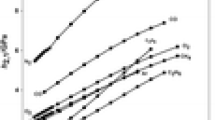Abstract
A method for the analysis of precise gas solubility data is presented and applied to new determinations of the Henry constant, k2, for He, Ne, Ar, Kr, and Xe. The values of k2 are fitted to the same sets of temperature functions which we have tried for oxygen. Our previously proposed power series in 1/T, ln(k2/P )=a0+a1/T+a2/T2 (Mark I), gives the best 3-term fit within the temperature range 0–60°C. For use over the full range to the critical temperature of water, we have discovered a new function given by (T*)2ln(k2/P )=A0(T*)2+A1(1-T*)1/3+A2(1-T*)2/3(Mark II), where T*≡T/T c1 . It fits our data from 0–60°C nearly as well as Mark I; it fits high temperature data from other sources; and at the critical temperature of water it satisfies theoretical requirements. Expansion of Mark II reveals the relationship between Mark II and Mark I and leads to a 4-term smoothing function, ln(k2/P )=a−2(T*)−2+a−1(T*)−1+a0+a1T* (Mark III), which we believe gives the best values only for the 0–60°C range. Mark III is used to calculate values for\(\Delta \bar G^\theta ,\Delta \bar H^\theta ,\Delta \bar S^\theta \), and\(\Delta \bar C^\theta \), 0–60°C, and a procedure is empolyed to estimate the errors. Agreement is excellent between these results and those obtained from precise microcalorimetric measurements made by others. With the inclusion of pressure correction terms, Mark II yields the four thermodynamic function changes for use at high temperatures. With increasing temperature, these changes suddenly turn upward toward plus infinity as T c1 is approached. Essentially direct determinations of\(\Delta \bar C^\theta \) for argon by other workers are in excellent agreement with our results. The symmetrical activity coefficient at infinite dilution, γ °2 is examined and the hypothetical properties of k2 are explored below 0°C. Mark II can be expressed in the reduced form (T*)2ln(k *2 )=A1(1-T*)1/3+A2(1-T*)2/3, where k *2 ≋k 2/(p c1φ2c1). A2 is a very good linear fit to A1, which suggests a characteristic temperature for water at 287.3 K.
Similar content being viewed by others
References
B. B. Benson, D. Krause, Jr., and M. A. Peterson,J. Solution Chem. 8, 655 (1979).
Water, A Comprehensive Treatise, F. Franks, ed., (Plenum Press, New York, 1972).
F. H. Stillinger,Science 209, 451 (1980).
B. B. Benson,Proceedings Symposium on Marine Geochemistry (University of Rhode Island, Providence, 1964).
R. H. Bieri, inThe Sea, E. D. Goldberg, ed., (John Wiley and Sons, New York, 1974), Chap. 6.
W. J. Jenkins,J. Marine Res. 38, 533 (1980).
J. S. Hovis, J. J. McKeown, D. Krause, Jr., and B. B. Benson, inGas Transfer at Water Surfaces, W. Brutsaert and G. H. Jirka, eds. (D. Reidel, Boston, 1984), pp. 403–411.
R. Battino and H. L. Clever,Chem. Rev. 66, 395 (1966).
E. Wilhelm, R. Battino, and R. J. Wilcock,Chem. Rev. 77, 219 (1977).
T. R. Rettich, Y. P. Handa, R. Battino, and E. Wilhelm,J. Phys. Chem. 85, 3230 (1981).
B. B. Benson and D. Krause, Jr.J. Solution Chem. 18, 803 (1989).
T. Enns, P. F. Scholander, and E. D. Bradstreet,J. Phys. Chem. 69, 389 (1965).
J. C. Moore, R. Battino, T. R. Rettich, Y. P. Handa, and E. Wilhelm,J. Chem. Eng. Data 27, 22 (1982).
R. F. Weiss and T. K. Kyser,J. Chem. Eng. Data 23, 69 (1978).
W. L. Masterton,J. Chem. Phys. 22, 1830 (1954).
T. R. Rettich, R. Battino, and E. Wilhelm,J. Solution Chem. 13, 335 (1984).
W. A. Gerth,J. Solution Chem. 12, 655 (1983), and references therein.
J. M. H. L. Sengers, M. Klein, and J. S. Gallagher, inAmerican Institute of Physics Handbook, 3rd edn., D. E. Gray and M. W. Zemansky, eds., (McGraw-Hill. New York, 1972).
J. H. Dymond and E. B. Smith,The Virial Coefficients of Pure Gases and Mixtures (Clarendon Press, Oxford, 1980).
J. P. O'Connell, Ph.D. Thesis, University of California, Berkeley, 1967.
B. B. Benson and D. Krause, Jr.,J. Chem. Phys. 64, 689 (1976).
S. Valentiner,Z. Phys. 42, 253 (1927).
E. C. W. Clarke and D. N. Glew,Trans. Faraday Soc. 62, 539 (1966).
E. F. Stephan, N. S. Hatfield, R. S. Peoples, and H. A. H. Pray, USAEC BMI-1067 (1956).
D. Beutier and H. Renon,AIChE J. 24, 1122 (1978).
W. Hayduk and H. Laudie,AIChE J. 19, 1233 (1973).
H. A. Pray, C. E. Schweickert, and B. H. Minnich,Ind. Eng. Chem. 44, 1146 (1952).
R. W. Potter II and M. A. Clynne,J. Solution Chem. 7, 837 (1978).
R. Crovetto, R. Fernandez-Prini, and M. L. Japas,J. Chem. Phys. 76, 1077 (1982).
J. T. Phillips, C. U. Linderstrom-Lang, and J. Bigeleisen,J. Chem. Phys. 56, 5053 (1972).
C. E. Klots and B. B. Benson,J. Marine Res. 21, 48 (1963).
A. Ben Naim and S. Baer,Trans. Faraday Soc. 59, 2735 (1963).
E. Douglas,J. Phys. Chem. 68, 169 (1964).
C. N. Murray and J. P. Riley,Deep-Sea Res. 17, 203 (1970).
R. F. Weiss,J. Chem. Eng. Data 16, 235 (1971).
P. F. Scholander,J. Biol. Chem. 167, 235 (1947).
G. Olofsson, A. A. Oshodi, E. Qvarnström, and I. Wadsö,J. Chem. Thermodyn. 16, 1041 (1984).
S. F. Dec and S. J. Gill,J. Solution Chem. 14, 417 (1985).
D. R. Biggerstaff, D. E. White, and R. H. Wood,J. Phys. Chem. 89, 4378 (1985).
Author information
Authors and Affiliations
Rights and permissions
About this article
Cite this article
Krause, D., Benson, B.B. The solubility and isotopic fractionation of gases in dilute aqueous solution. IIa. solubilities of the noble gases. J Solution Chem 18, 823–873 (1989). https://doi.org/10.1007/BF00685062
Received:
Revised:
Issue Date:
DOI: https://doi.org/10.1007/BF00685062




